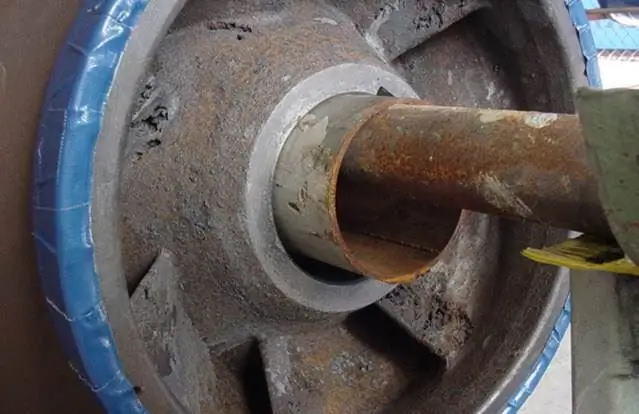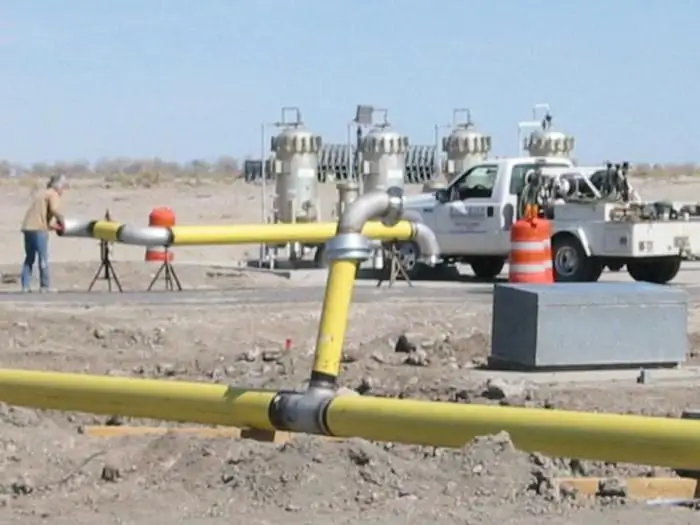2026 Author: Howard Calhoun | [email protected]. Last modified: 2025-01-24 13:10:38
Corrosion is a chemical and electrochemical reaction of a metal with its environment, causing damage to it. It flows at different speeds, which can be reduced. From a practical point of view, of interest is the anti-corrosion cathodic protection of metal structures in contact with the ground, water and transported media. The outer surfaces of pipes are especially damaged by the influence of soil and stray currents.

Inside corrosion depends on the properties of the medium. If it is a gas, it must be thoroughly cleaned from moisture and aggressive substances: hydrogen sulfide, oxygen, etc.
Working principle
The objects of the process of electrochemical corrosion are the environment, the metal and the interface between them. The medium, which is usually moist soil or water, has good electrical conductivity. An electrochemical reaction takes place at the interface between it and the metal structure. If the current is positive (anode electrode), the iron ions pass into the surrounding solution, resulting in a mass loss of the metal. The reaction causes corrosion. With a negative current (cathode electrode), these losses are absent, since inelectrons are transferred to the solution. The method is used in electroplating for coating steel with non-ferrous metals.
Cathodic corrosion protection is achieved when a negative potential is applied to an iron object.

To do this, an anode electrode is placed in the ground and a positive potential is connected to it from a power source. The minus is applied to the protected object. Cathodic-anodic protection leads to active corrosion destruction of only the anode electrode. Therefore, it should be changed periodically.
Negative effect of electrochemical corrosion
Corrosion of structures can occur from the action of stray currents from other systems. They are useful for target objects, but cause significant damage to nearby structures. Stray currents can spread from the rails of electrified vehicles. They pass towards the substation and enter the pipelines. When leaving them, anode sections are formed, causing intense corrosion. For protection, electrical drainage is used - a special removal of currents from the pipeline to their source. Cathodic protection of pipelines against corrosion is also possible here. To do this, you need to know the amount of stray currents, which is measured by special devices.

According to the results of electrical measurements, a method of protecting the gas pipeline is selected. A universal remedy is a passive method of isolating pipes from contact with the ground using insulating coatings. Cathodic protection of the gas pipeline refers to the active method.

Protection of pipelines
Designs in the ground are protected from corrosion if you connect the minus of a DC source to them, and the plus to the anode electrodes buried nearby in the ground. The current will go to the structure, protecting it from corrosion. In this way, cathodic protection of pipelines, tanks or pipelines located in the ground is carried out.

The anode electrode will degrade and should be replaced periodically. For a tank filled with water, the electrodes are placed inside. In this case, the liquid will be the electrolyte through which the current will flow from the anodes to the surface of the container. The electrodes are well controlled and easy to change. In the ground, this is more difficult to do.
Power supply
Near oil and gas pipelines, in heating and water supply networks that require cathodic protection, stations are installed from which voltage is supplied to objects. If they are placed outdoors, their degree of protection must be at least IP34. Any is suitable for dry rooms.
Stations for cathodic protection of gas pipelines and other large structures have a capacity of 1 to 10 kW.

Their energy parameters primarily depend on the following factors:
- resistance between soil and anode;
- soil conductivity;
- protection zone length;
- insulating action of the coating.
Traditionally, a cathodic protection converter is a transformer installation. Now it is being replaced by an inverter one, which has smaller dimensions, better current stability and greater efficiency. In important areas, controllers are installed that have the functions of regulating current and voltage, equalizing protective potentials, etc.
Equipment is presented on the market in various versions. For specific needs, individual design is used to ensure the best operating conditions.
Power source parameters
For corrosion protection for iron, the protective potential is 0.44 V. In practice, it should be larger due to the influence of inclusions and the condition of the metal surface. The maximum value is 1 V. In the presence of coatings on the metal, the current between the electrodes is 0.05 mA/m2. If the insulation fails, it rises to 10mA/m2.
Cathodic protection is effective in combination with other methods, since less electricity is consumed. If there is a paint coating on the surface of the structure, only the places where it is broken are protected by the electrochemical method.
Features of cathodic protection
- Powered by stations or mobile generators.
- The location of anode grounding depends on the specifics of pipelines. The placement method can be distributed or concentrated, as well as located at different depths.
- The anode material is selected with low solubility to last for 15 years.
- Protective potentialfields for each pipeline is calculated. It is not regulated if there are no protective coatings on the structures.
Gazprom standard requirements for cathodic protection
- Of action during the entire life of protective equipment.
- Surge protection.
- Placement of the station in block boxes or in a stand-alone anti-vandal design.
- Anode grounding is selected in areas with minimal electrical resistance of the soil.
- The characteristics of the transducer are selected taking into account the aging of the protective coating of the pipeline.
Tread protection
The method is a type of cathodic protection with the connection of electrodes from a more electronegative metal through an electrically conductive medium. The difference lies in the absence of an energy source. The tread absorbs corrosion by dissolving into an electrically conductive environment.
In a few years the anode should be replaced as it wears out.
The effect of the anode increases with a decrease in its contact resistance with the medium. Over time, it can become covered with a corrosive layer. This leads to a breakdown in electrical contact. By placing the anode in a s alt mixture that dissolves corrosion products, the efficiency is improved.
The protector's influence is limited. The range is determined by the electrical resistance of the medium and the potential difference between the anode and cathode.
Protective protection is used in the absence of energy sources or when their useeconomically impractical. It is also disadvantageous in acidic applications due to the high dissolution rate of the anodes. Protectors are installed in water, in soil or in a neutral environment. Anodes are usually not made of pure metals. Zinc dissolves unevenly, magnesium corrodes too quickly, and a strong oxide film forms on aluminum.
Tread materials
In order for the protectors to have the necessary performance properties, they are made from alloys with the following alloying additives.
- Zn + 0.025-0.15% Cd+ 0.1-0.5% Al - protection of equipment in sea water.
- Al + 8% Zn +5% Mg + Cd, In, Gl, Hg, Tl, Mn, Si (fractions of a percent) - operation of structures in flowing sea water.
- Mg + 5-7% Al +2-5% Zn - protection of small structures in soil or water with low s alt concentration.
Incorrect use of some types of protectors leads to negative consequences. Magnesium anodes can cause equipment cracking due to the development of hydrogen embrittlement.
Combined sacrificial cathodic protection with anti-corrosion coatings increases its effectiveness.

Protective current distribution is improved and significantly fewer anodes are required. A single magnesium anode protects a bitumen-coated pipeline for 8 km, and an uncoated pipeline for only 30 m.
Protecting car bodies from corrosion
If the coating is broken, the thickness of the car body can decrease up to 1 mm in 5 years, i.e.rust through. The restoration of the protective layer is important, but in addition to it, there is a way to completely stop the corrosion process using cathodic-protective protection. If you turn the body into a cathode, the corrosion of the metal stops. Anodes can be any conductive surfaces located nearby: metal plates, ground loop, garage body, wet road surface. In this case, the protection efficiency increases with an increase in the area of the anodes. If the anode is a road surface, a "tail" of metallized rubber is used to contact it. It is placed opposite the wheels so that splashes get better. "Tail" is isolated from the body.
The battery plus is connected to the anode through a 1 kΩ resistor and an LED connected in series with it. When the circuit is closed through the anode, when the minus is connected to the body, in normal mode the LED barely noticeably glows. If it burns brightly, then a short circuit has occurred in the circuit. The cause must be found and eliminated.
For protection, a fuse must be installed in series in the circuit.
When the car is in the garage, it is connected to a grounding anode. While driving, the connection is made through the "tail".
Conclusion
Cathodic protection is a way to improve the operational reliability of underground pipelines and other structures. At the same time, its negative impact on neighboring pipelines from the influence of stray currents should be taken into account.
Recommended:
Customer Service: Rules and Standards, Principles and Methods

The competition in trade is huge these days. Customers are now very demanding, and therefore the service must be at a high level. This means that people no longer have enough of a large assortment and budget prices. So how do you keep your customers and improve your service?
Corrosion and erosion of metals: causes and methods of protection

Chemical, mechanical and electrical external influences often occur in metal product operating environments. As a result, with improper maintenance of such elements, as well as ignoring safety standards, there may be risks of deformation and damage to structures and parts. This is due to the emerging processes of corrosion and erosion of metals, which in the long term contribute to the complete destruction of the structure of the product
Cathodic corrosion protection of pipelines: equipment, principle of operation

The article is devoted to the cathodic protection of pipelines from corrosion. The types of stations that implement such protection and the principle of operation of the technique are considered
Mulch - what is it? Protection and nutrition for soil microflora and fauna

Now more and more often they talk about loosening the soil with flat cutters, followed by mulching the surface of the earth. Why carry out this agricultural technique, what materials are mulch made of, what will it give the farmer in the end, which is called the harvest?
Instruction on labor protection for an engineer on labor protection, equipment operation

Almost every large enterprise has a labor protection specialist. The essence of his work is to maintain safety standards in the organization. No less important is the presence of a special document called "Labor Protection". All these things will be discussed further

